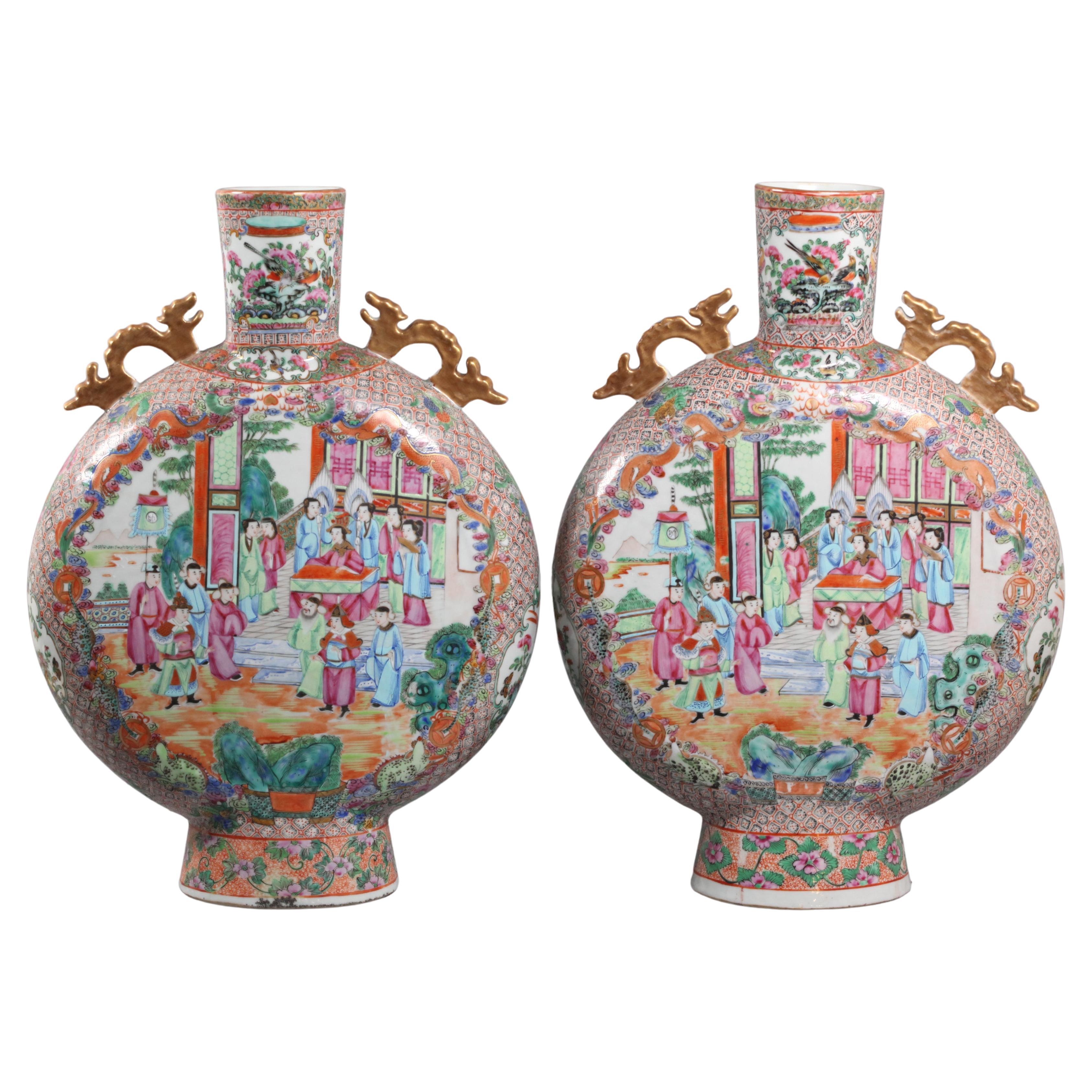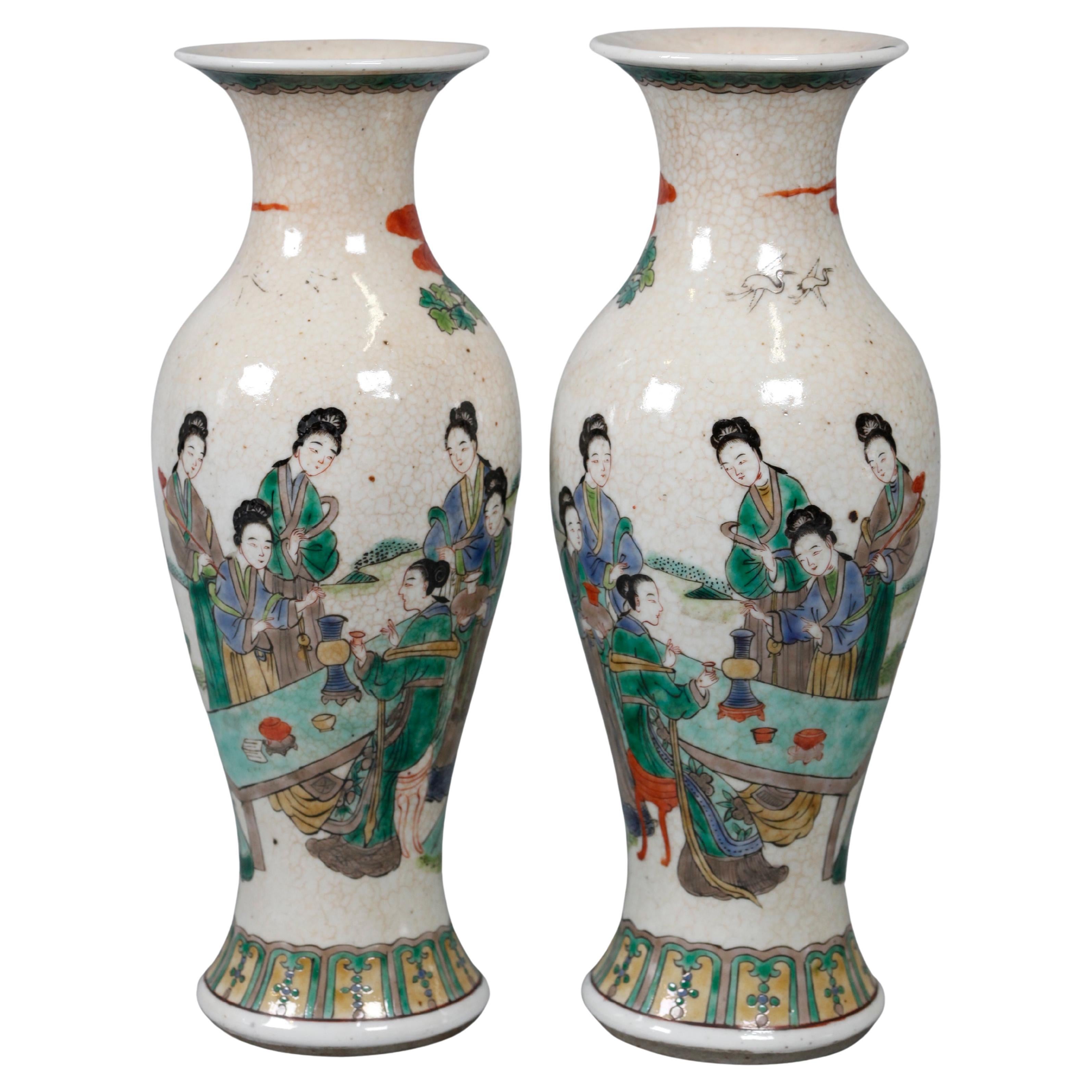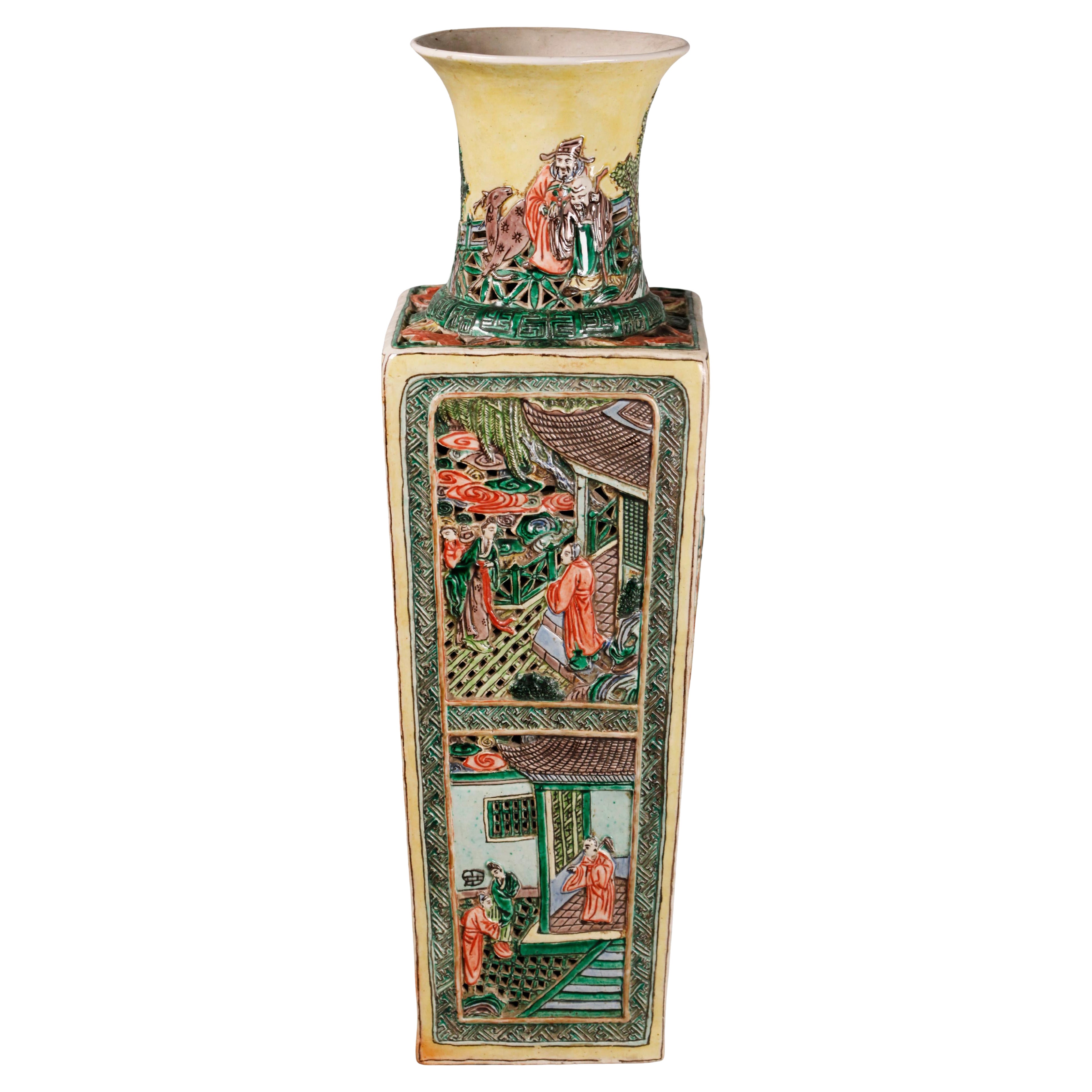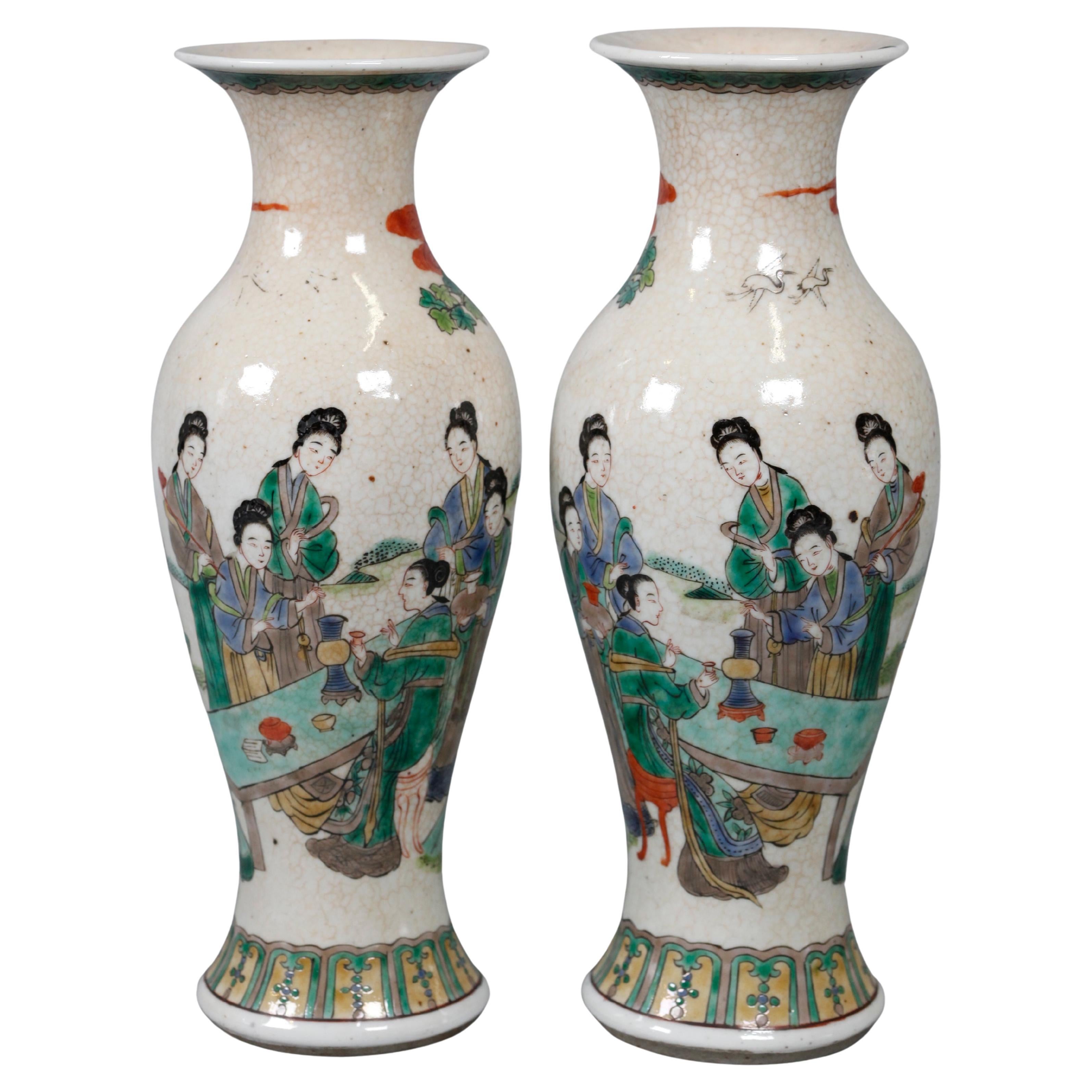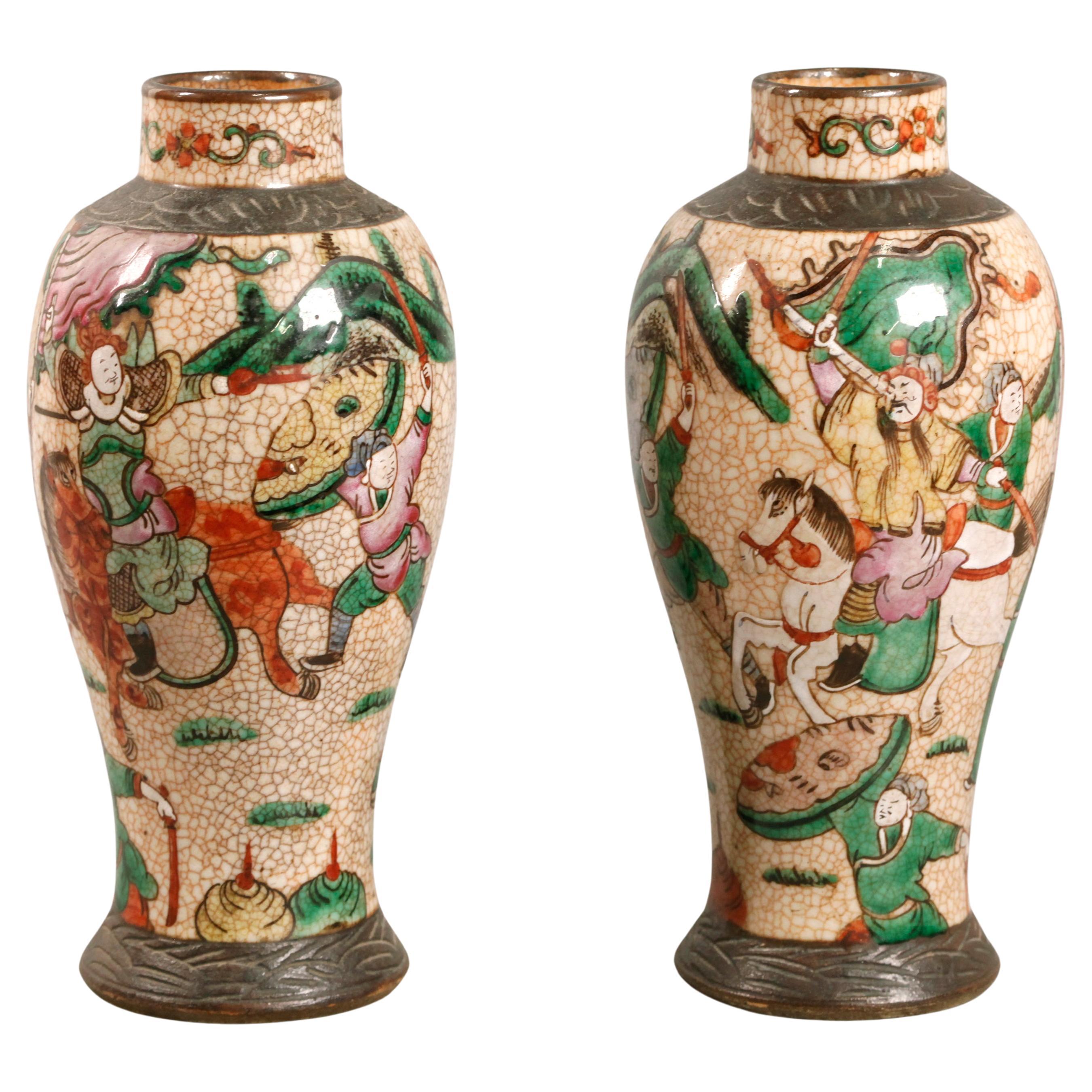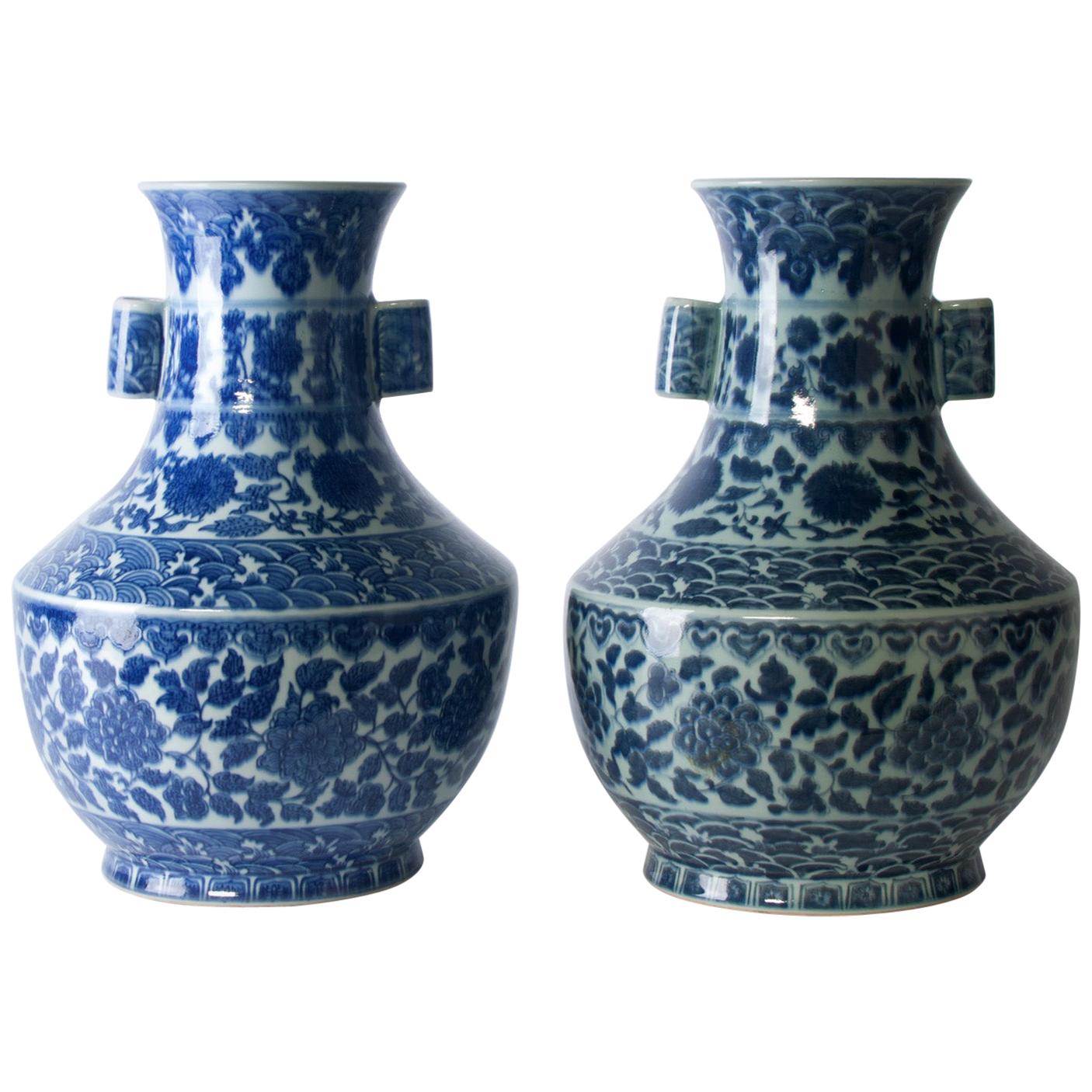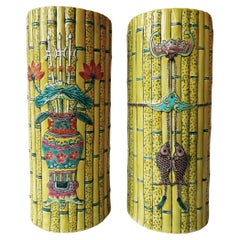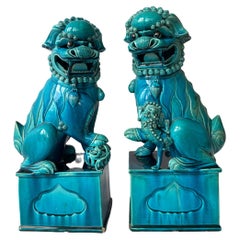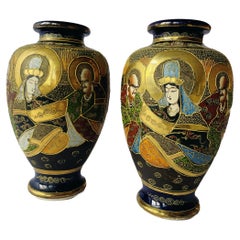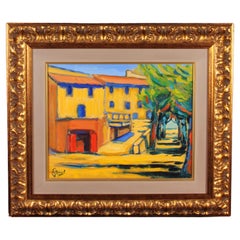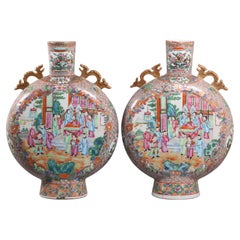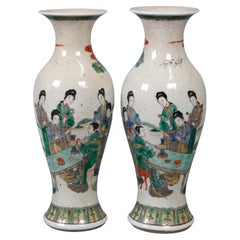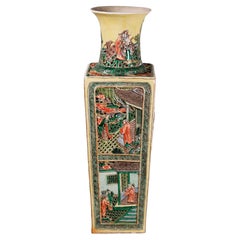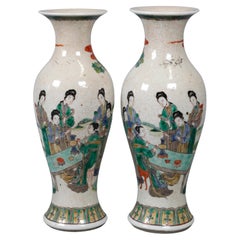Items Similar to Pair of Moon-Shaped Vases, China Late 19th Century
Video Loading
Want more images or videos?
Request additional images or videos from the seller
1 of 16
Pair of Moon-Shaped Vases, China Late 19th Century
About the Item
A pair of large moon-shaped "flasks" vases painted in blue and white, each flask decorated with scenes of active characters and surrounded by borders of floral motifs and foliate patterns. The narrow neck has Chi’en Lung motifs on the shoulders depicting a pair of dragon lug handles on a flattened cylindrical body.
Origin: The moon-shaped vases originated from the Qing dynasty (1644-1912) during the reign of Emperor Qianlong, who was also known as Chi'en Lung. They were produced in Jingdezhen, a city in Jiangxi province, which was renowned for its porcelain production.
Shape: Moon-shaped vases are characterized by their unique form, resembling a crescent moon. They have a convex body with a narrow neck and flared rim, providing a distinct visual appeal.
Blue-on-White Porcelain: The blue-on-white color scheme is a classic and iconic style of Chinese porcelain. The cobalt blue pigment was applied to the white porcelain surface before firing, resulting in a contrasting and elegant design.
Chi'en Lung Dragon Motif: The narrow neck of the vase often features a decorative motif known as the Chi'en Lung dragon. This motif represents the imperial dragon, a symbol of power, strength, and good fortune in Chinese culture. The dragon is typically depicted with a sinuous body, elongated claws, and a fierce expression.
Symbolism: Moon-shaped vases are steeped in symbolism. The crescent moon shape represents yin (feminine) energy, symbolizing receptivity and tranquility. Dragons, on the other hand, are associated with yang (masculine) energy, symbolizing strength and protection. The combination of these elements represents a harmonious balance of energies.
Artistic Skill: The production of moon-shaped vases required exceptional craftsmanship and technical expertise. Skilled artisans meticulously painted the intricate blue designs by hand, displaying their mastery in creating detailed patterns and capturing the essence of the dragon motif.
Collector's Items: Moon-shaped vases from the late 19th century are highly sought after by collectors and enthusiasts of Chinese porcelain. Their historical significance, artistic value, and limited availability contribute to their desirability in the art market.
Rarity: Due to their age and the delicate nature of porcelain, moon-shaped vases from the late 19th century are relatively rare. Surviving examples such as these in such good condition are particularly prized, as many antique pieces may have suffered damage or wear over time.
Heritage and Cultural Significance: Moon-shaped vases reflect the rich heritage and artistic traditions of Chinese porcelain. They serve as a testament to the mastery of Chinese artisans and their ability to create enduring works of art that continue to captivate admirers around the world.
- Dimensions:Height: 17.72 in (45 cm)Width: 10.63 in (27 cm)Depth: 3.94 in (10 cm)
- Sold As:Set of 2
- Materials and Techniques:
- Place of Origin:
- Period:
- Date of Manufacture:Late 19th Century
- Condition:Wear consistent with age and use.
- Seller Location:Ixelles, BE
- Reference Number:1stDibs: LU8924234981492
About the Seller
No Reviews Yet
Vetted Professional Seller
Every seller passes strict standards for authenticity and reliability
1stDibs seller since 2023
- ShippingRetrieving quote...Shipping from: Ixelles, Belgium
- Return Policy
Authenticity Guarantee
In the unlikely event there’s an issue with an item’s authenticity, contact us within 1 year for a full refund. DetailsMoney-Back Guarantee
If your item is not as described, is damaged in transit, or does not arrive, contact us within 7 days for a full refund. Details24-Hour Cancellation
You have a 24-hour grace period in which to reconsider your purchase, with no questions asked.Vetted Professional Sellers
Our world-class sellers must adhere to strict standards for service and quality, maintaining the integrity of our listings.Price-Match Guarantee
If you find that a seller listed the same item for a lower price elsewhere, we’ll match it.Trusted Global Delivery
Our best-in-class carrier network provides specialized shipping options worldwide, including custom delivery.More From This Seller
View AllPair of 19th Century Qing Dynasty Faux Bamboo Chinese Vases
Located in Ixelles, BE
Faux bamboo Chinese vases were a type of decorative art that emerged during the Qing Dynasty (1644-1912) in China. These porcelain vases were designed to mimic the appearance of bamboo, a plant highly regarded in Chinese culture for its resilience, elegance, and symbolism. Bamboo is associated with attributes such as flexibility, strength, and modesty, making it a popular motif in Chinese art.
In the Qing Dynasty the color yellow held significant symbolism and represented imperial authority, power, and the emperor himself. Yellow was considered the most sacred and prestigious color in Chinese culture, and it had strong associations with the emperor's position as the Son of Heaven and the ruler of all under heaven.
The marks at the bottom of the vases indicate that these were crafted more specifically during the Tongzhi period – an emperor who reigned from 1861 to 1875, which effectively lasted nthrough his adolescence and was largly overshadowed by the rule of his mother, Empress Dowager Cixi. Although he had little influence over state affairs, the events of his reign gave rise to what historians call the “Tongzhi Restoration”, an unsuccessful modernization program.
The polychrome enamels representing on one vase a traditional Chinese kite...
Category
Antique Late 19th Century Chinese Chinese Export Ceramics
Materials
Porcelain
£1,926 Sale Price / set
20% Off
Large Pair of Graduated Turquoise Porcelain Foo Dogs. Chinese Circa 1880
Located in Ixelles, BE
Chinese turquoise-colored porcelain foo dogs from circa 1880 are exquisite examples of traditional Chinese ceramic art. Foo dogs, also known as guardian lions or temple lions, are ic...
Category
Antique Late 19th Century Chinese Qing Ceramics
Materials
Ceramic
£5,985 Sale Price / set
20% Off
Pair of Japanese Moriage Satsuma Vases with Gold Gilding Circa 1930-1940
Located in Ixelles, BE
Japanese Satsuma vases from the circa 1930-1940 period are a particular style of ceramic art that originated from the Satsuma province of Japan. Satsuma ware is renowned for its intricate hand-painted designs, rich colors, and distinctive crackled glaze.
Satsuma ware dates back to the early 17th century, but it gained widespread popularity in the late 19th and early 20th centuries, including the 1930s and 1940s. Satsuma vases produced during this time often reflected a mix of traditional and modern influences, as Japan went through a period of cultural exchange and artistic experimentation.
Satsuma vases are made from a type of Japanese earthenware clay known for its fine texture and malleability. The vases are hand-formed or wheel-thrown and then meticulously hand-painted with intricate designs using enamel paints. The distinctive crackled glaze was achieved by firing the vases at a relatively low temperature, allowing the glaze to crack during the cooling process.
The moriage technique involves applying three-dimensional, raised ornamentation to the surface of the ceramic piece, creating a visually textured and layered effect. Artisans create three-dimensional patterns, designs, or intricate motifs using a special mixture of clay, slip, or porcelain paste. The raised elements are added by hand to the ceramic body, and each detail is carefully shaped to achieve the desired effect.
The moriage is then gold gilded as some of the intricate ornamental patterns and the halos around the three immortal...
Category
Early 20th Century Japanese Showa Ceramics
Materials
Pottery
Antoine Giroux Fauvist Painting - Corsica - Ref 040
By Antoine Giroux
Located in Ixelles, BE
Antoine Giroux: Capturing the Vibrancy of the Mediterranean
Born in Brussels in 1955, Antoine Giroux's journey to artistic expression took a unique path through the realms of music ...
Category
Mid-20th Century Belgian Paintings
Materials
Canvas, Paint
£1,265 Sale Price
20% Off
Antoine Giroux Fauvist Painting - Coastal Water Front - Ref 134
By Antoine Giroux
Located in Ixelles, BE
Antoine Giroux: Capturing the Vibrancy of the Mediterranean
Born in Brussels in 1955, Antoine Giroux's journey to artistic expression took a unique path through the realms of music ...
Category
Late 20th Century Belgian Paintings
Materials
Canvas, Paint
£1,031 Sale Price
20% Off
Antoine Giroux Fauvist Painting - French Riviera Landscape - Ref 408
By Antoine Giroux
Located in Ixelles, BE
Antoine Giroux: Capturing the Vibrancy of the Mediterranean
Born in Brussels in 1955, Antoine Giroux's journey to artistic expression took a unique path through the realms of music ...
Category
Late 20th Century Belgian Paintings
Materials
Canvas, Paint
You May Also Like
Pair of Chinese Porcelain Moon Flask Form Vases, 19th Century
Located in New York, NY
figural scene on one side, and bird, flower, butterfly motif on the other side
Category
Antique Mid-19th Century Chinese Antiquities
Materials
Porcelain
Pair of Chinese Porcelain Vases, 19th Century
Located in New York, NY
decorated with a multicolor figural scene
Category
Antique Mid-19th Century Chinese Antiquities
Materials
Porcelain
£1,515 / set
Chinese square shaped porcelain vase, 19th c.
Located in New York, NY
decorated with figural scenes on yellow ground
Category
Antique Late 19th Century Chinese Antiquities
Materials
Porcelain
Pair of Chinese Porcelain Vases, 19th c.
Located in New York, NY
decorated with a multicolor figural scene
Category
Antique Mid-19th Century Chinese Antiquities
Materials
Porcelain
£1,136 / set
pair of Chinese porcelain vases, 19th c.
Located in New York, NY
decorated with scenes of warriors
Category
Antique Late 19th Century Chinese Antiquities
Materials
Porcelain
£757 / set
19th Century Chinese Vases
Located in Esbeek, NL
Beautiful 19th century vases.
Category
Antique Late 19th Century Chinese Vases
Materials
Porcelain
£3,439 / set
Recently Viewed
View AllMore Ways To Browse
19th Century Icon
Late 19th Century Chinese Porcelain
Chinese Jingdezhen
Pair 19th Century Blue And White
Chinese Moon
Crescent Moon Art
Pair Of 19th Century Chinese Blue
Chinese Imperial Porcelain
Rare Antique Chinese Vases
Rare Antique Asian Vases
Flask Vase
Pair Cylinder Vase
Fortune Dragon
Chinese Cylinder Vase
White Moon Vase
Qianlong Vase
Qing Dynasty Vase Pair
Pair Of Chinese Qing Dynasty Vases
